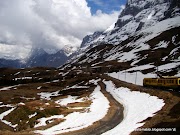It is quite an extraordinary thing to visit a town that was already featured in Dante's Inferno and has changed so little over the centuries that it would likely be recognizable to the great poet in its present form. Built at a time Florence and Siena were not really on peaceful terms, Monteriggioni was a defensive outpost of the neighboring Sienese against the Florentines for centuries. Though invading armies put the massive city walls and the 14 towers to the test several times, nobody actually managed to conquer the town. At least not by force: in an act still referred to by locals as "the great betrayal", the captain of the town's defenders (an exiled Florentine) simply handed the keys to the city to the enemy in 1554.
Nem mindennapi dolog olyan városba ellátogatni, amelyről már Dante is írt a Pokolban és amely annyira keveset változott az évszázadok során, hogy a nagy költő jó eséllyel mai formájában is felismerné. Monteriggioni eredetileg azért épült, hogy a szomszédos Siena védelmét szolgálja Firenze ellen. Az évszázadok során számos hadsereg ostromolta a masszív, 14 toronnyal ellátott falakat, de senkinek sem sikerült bevenni a várost. Erővel legalábbis nem: 1554-ben a védők (korábban Firenzéből száműzött és Siena oldalára állt) parancsnoka egyszerűen átnyújtotta a város kulcsait a firenzei csapatoknak. A helyiek ma is "a nagy árulás"-ként emlegetik az eseményt.
 |
| Monteriggioni |
As opposed to some other Italian towns I have written (or will write) about, Monteriggioni is no longer off the beaten track. Certain places swarm with tourists 365 days a year. It is still possible to see Monteriggioni without the crowds, but timing is crucial. It was a sunny day right before Easter when I took the first photo of this post: the parking lot right outside the city walls was overflowing with cars and tour buses. Yet during another visit, on an overcast weekday in late October, we basically had entire Monteriggioni to ourselves.
Ellentétben néhány egyéb olasz kisvárossal, amelyekről írtam (vagy írni fogok), Monteriggioni már távolról sem egy elfeledett és felfedezetlen hely. Vannak helyek, ahol az év minden napján rengeteg a turista. Monteriggioniban még nem feltétlenül kell több száz másik turistával együtt sétálni az apró sikátorokban, az időzítés azonban fontos. A bejegyzés első fényképét egy napfényes tavaszi napon készítettem, közvetlenül Húsvét előtt: a városfal tövében lévő parkolóban mozdulni nem lehetett az autóktól és a turistabuszoktól. Egy felhős októberi hétköznapon viszont szinte csak mi voltunk az egész városban.
 |
| Monteriggioni |
 |
| Monteriggioni |
 |
| Monteriggioni: Fall colors / Őszi színek |





